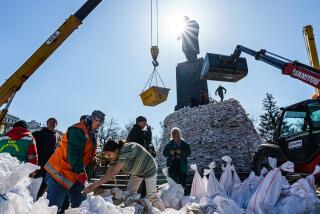Clan Rivalries Sowed Seeds of Conflict
- Share via
Russians say that in every victory there is a defeat, and in every defeat a victory. As the West grows increasingly alarmed at the grim prospects of a Chechen defeat, it is helpful to consider how the seeds of the cataclysm were sown by Chechnya’s triumph over Russian forces in 1996.
During the previous conflict, Chechens were united in their struggle with Moscow, while Russians were deeply divided in their views of that disastrously unpopular war. Yet in the three years after the war, Chechen solidarity disintegrated in the face of Chechnya’s traditional clan rivalries.
In Chechnya, blood is everything. Chechen social organization is based on entrenched kinship hierarchies without a history of overarching political organization, save that which was imposed from Moscow. Chechnya is in many ways a pre-modern society, and no sooner did it free itself from Moscow than it proved itself incapable of constructing a modern nation-state. In compensation for this absence of political organization, the Chechens had recourse to three expedients, all of which proved disastrous.
First, Chechens found comfort in their national mythology. In their ferocious resistance of Russian imperial forces in the early 19th century, Chechens united with their Dagestani neighbors under the legendary Imam Shamil, who was himself Dagestani. The enduring legacy of the struggle was a heroic mythology that served as inspiration for, and drew further intensification from, the 1994 to 1996 conflict.
Chechens like to say that a Chechen fighter is worth one Russian tank or a hundred Russian soldiers. Yet this warrior mythology is self-destructive, particularly because it is self-perpetuating. The Chechen self-conception is an altar that demands human sacrifice. Hence the dual invasions of Dagestan in August and September by Chechen warlord Shamil Basayev.
As a principal feature of Chechen self-conception, Islam also served as an expedient through which the Chechens sought to address the deficiencies of their political organization. The Sufi brotherhood, which was the organizational basis of Imam Shamil’s 19th century resistance, has emerged as a principled force for education, moderation and tolerance in neighboring Dagestan. Yet its role in Chechnya was complicated not only by warrior mythology and clan-based membership but by an ideological intensification that occurred during the last three years as competing clan leaders staged appeals to Islam in order to obtain political legitimacy.
It also was complicated by the introduction of Wahhabite Islamic fundamentalism, which spread rapidly through Chechnya and Dagestan with the help of supporters in the Persian Gulf, Pakistan and Afghanistan, including suspected terrorist Osama bin Laden. Yet the spread of Wahhabism was also a response to the deepening impoverishment of the region.
Hampered by their lack of effective political organization, and by their reflexive resort to a raiding tradition that is part of their mythology, Chechens have been unable to organize a legitimate economy. Apart from subsistence farming and barter, income is earned by organized crime, by the widespread tapping of the petroleum pipeline bound for the West, by kidnapping and, evidently, by counterfeiting $100 bills.
This economy of violent criminality has served as a further substitute for modern social organization. Chechens have been kidnapping Russians for hundreds of years, but since 1996 the practice has become one of Chechnya’s principal industries. More than 1,300 Westerners and Russians, including women and children, were taken hostage in those three years--more than one a day. Hostages are held under brutal conditions for exorbitant ransoms, which are extorted with the help of Chechen-produced video documentation of their torture and dismemberment, including that of the children.
Once taken, hostages are subsequently bought and sold among the Chechen clans, in much the same way as another culture might exchange money or securities. The result is a contemporary slave trade from which many Chechens have directly or indirectly benefited, and in which many are more or less accomplices.
Since social organization is dependent on kinship ties, Chechens are spared the moral complications that might come from a capacity to empathize with outsiders. Yet in line with the Russian maxim, this practice has had an ironic twist: The reason there have been no international observers or relief workers helping inside Chechnya is that the Chechens long ago murdered or kidnapped them all. Despite the complications of Moscow politics, despite its deficiency of candor and its unconscionable military excess, Russia’s current conflict has its roots in Chechnya’s clan culture, which perpetuates this violent criminality while preventing political integration.
The settlement negotiated in 1996 contributed to the Chechen myth of self-sacrificial militancy, and the tragedy is that another negotiated settlement would be unlikely to produce a different result. In a war in which it is difficult to distinguish “militants” from “civilians,” it may be impossible to identify the victor and the vanquished. The only clear victor is likely to be the dark and barbarous past.
More to Read
Sign up for Essential California
The most important California stories and recommendations in your inbox every morning.
You may occasionally receive promotional content from the Los Angeles Times.













